Many businesses use email marketing to connect with customers and promote deals.
However, using generic email marketing approaches for software-as-a-service (SaaS) companies can backfire.
The truth is that SaaS email marketing demands a tailored approach. It needs a special strategy to drive user activation, engagement, retention, and referrals.
In this article, we’ll look at the unique benefits of email marketing for SaaS companies. We’ll examine strategies to grow your subscriber list and the types of emails to send. We’ll also discuss email marketing platforms purpose-built for SaaS.
So, let’s get started.
What is SaaS email marketing?
SaaS email marketing is when companies that sell software online use emails to talk to their customers. They send updates, and tips to people who use their software. This helps customers understand how to use the software better and keeps them interested in it.
SaaS email marketing is different from ecommerce email marketing in a few ways:
- Purpose: SaaS emails focus on teaching and helping users with the software. They often send guides, tutorials, and product updates. Ecommerce emails try to sell products, promote sales, and show new items.
- Content: SaaS emails have more educational content to help users get the most out of the software. On the contrary, ecommerce emails are more about showcasing products and encouraging purchases.
- Customer Relationship: SaaS emails aim to build a long-term relationship with the customer, while ecommerce emails often focus on quick sales and immediate buying decisions.
The main benefits of email marketing for SaaS
Email is one of the most effective marketing channels for SaaS companies. It helps them connect with users across the customer lifecycle.
From acquisition to retention and expansion, email drives growth. Thanks to email marketing, SaaS companies reap many benefits, including:
1. Driving free trials and conversions
Welcome and onboarding emails boost activation rates by encouraging engagement and upgrading. This transforms prospects into active users.
2. Increasing retention and reducing churn
Ongoing lifecycle emails demonstrate key features and provide tips. This nurtures commitment, engagement, and loyalty. Renewal reminders also reduce cancellations by securing renewals from at-risk users.
3. Generating expansion revenue
Email is a growth catalyst. Upsell and cross-sell emails unlock extra lifetime value from customers. Segmented campaigns with relevant offers based on user types or attributes work well.
4. Building advocacy and referrals
Satisfied SaaS customers can become advocates. Referral emails with enticing incentives encourage them to invite others. This amplifies reach and acquisition.
5. Delivering targeted communication
User segmentation enables personalized, timed emails that drive higher engagement. Examples include emails celebrating user milestones. Their precise timing fosters solid relationships and prompts impactful user actions, driving growth.
6. Establishing direct communication
Email can become a dedicated channel linking SaaS companies directly with their users. Valuable content updates sent regularly foster mindshare, provide feedback channels, and sustain engagement.
7. Guiding user onboarding
Welcome and training emails ensure a smooth initiation into the SaaS product. They can delight new users and create a successful user journey.
8. Retaining customers
Feature update emails maintain commitment by keeping customers informed. This reduces churn risk. New features and a gentle nudge toward advanced plans remind them of the value ahead.
9. Collecting data-driven insights
Email analytics uncover performance trends and a wealth of wisdom. These inform strategies and product enhancements through an optimization cycle.
Email is a versatile channel that complements digital strategies. It engages users across lifecycle stages, making it an indispensable SaaS growth tool.
Main categories of SaaS email marketing
SaaS companies use email to connect with users across three primary categories:
- Marketing emails
- Lifecycle emails
- Transactional emails
These categories fulfill distinct yet interconnected purposes—engaging users effectively, fostering retention, and driving conversions.
Marketing emails
Email marketing serves as the forefront of communication strategies for SaaS companies.
They’re the media through which businesses tell their stories. SaaS companies can use them to captivate potential users with the promise of value.
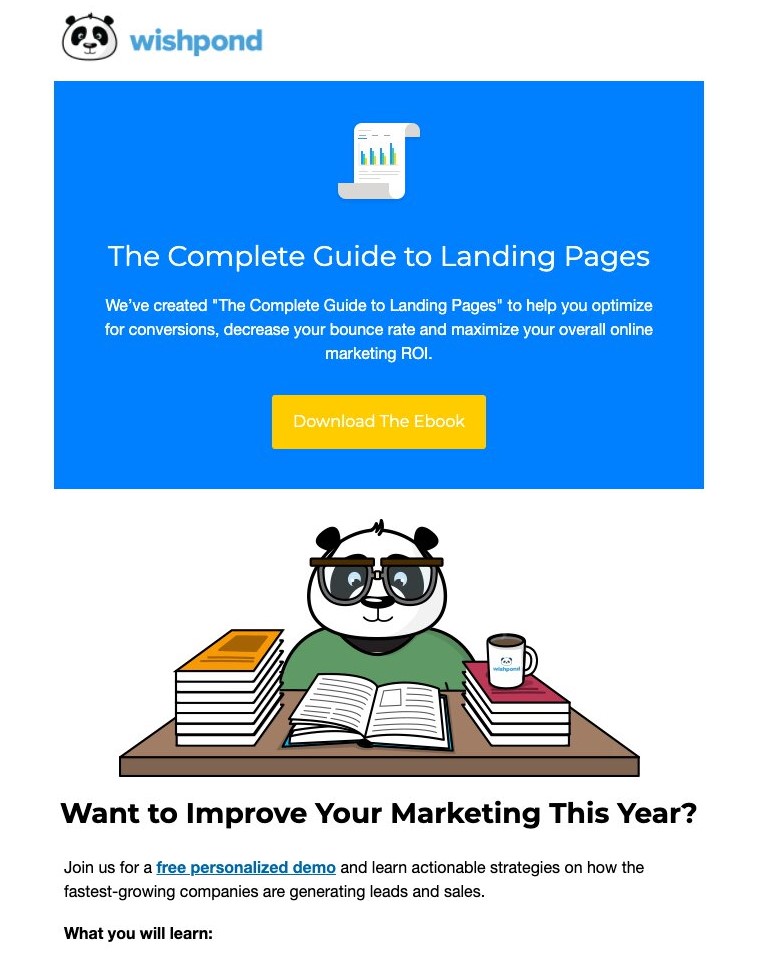
Source: Userlist
These emails attract and nurture new prospects. They guide them on their journey to become customers. Common marketing email types include:
Cold outreach. Introductory emails that describe product benefits tailored to prospect needs. For example, an email focused on the accounting features of a SaaS platform for finance teams. Outreach emails aim to capture attention with relevant messaging.
Free trial promotion. Emails that encourage prospects to experience a product firsthand through free trials. Offers like extended trial periods, discounts, or bonus features incentivize signups. The goal is to convert prospects into engaged users.
Webinar/event invites. Emails promoting in-person or virtual events for prospects. For example, a monthly user Q&A webinar. These build mindshare by providing value beyond the product.
Abandoned trial re-engagement. Emails to re-engage prospects who showed intent but didn’t convert. Personalized messaging addresses concerns and motivates desired actions.
New feature announcements. Emails showcasing platform updates, new capabilities, or content. They highlight innovation and ongoing product experience enhancements for prospects and existing users.
Lead nurturing. Ongoing drip campaigns with helpful content for prospects based on the buyer’s journey. Nurturing builds trust and primes users for conversion.
Retargeting. Emails that follow up website visits by recommending relevant content or offers. Retargeting keeps your brand top of mind after initial prospect engagement.
Marketing emails should show insight into prospect needs and thoughtful nurturing journeys. Use them to convey the unique value of your SaaS solution. They attract and develop new prospects to become loyal customers.
Lifecycle emails
Lifecycle emails guide users through their interactions with a SaaS product. From initiation to growth, they engage users across the entire customer journey.
For instance, picture a SaaS email software. Its goals include retaining customers and enhancing their experience.
A lifecycle email could offer insights into optimizing marketing automation. It could also give users actionable tips to maximize the software’s potential.
Examples of lifecycle emails include:
Welcome series. Post sign-up emails that ease the onboarding process. They offer tips and tutorials tailored to the user’s role. Welcome series activate accounts and boost initial usage.
Education/tips. Ongoing emails that showcase product capabilities. They explain use cases and workarounds for common problems. They encourage deeper feature adoption.
Surveys. Emails requesting user feedback about their experience. Their goal is to uncover pain points and improvement opportunities. Surveys provide valuable insights.
Anniversary/milestone. Emails acknowledging usage milestones or tenure that make users feel valued. Milestones like the first report created or the first anniversary build loyalty.
Re-engagement. Personalized emails to inactive users inquiring why they left and addressing concerns. Re-engagement emails reduce preventable churn.
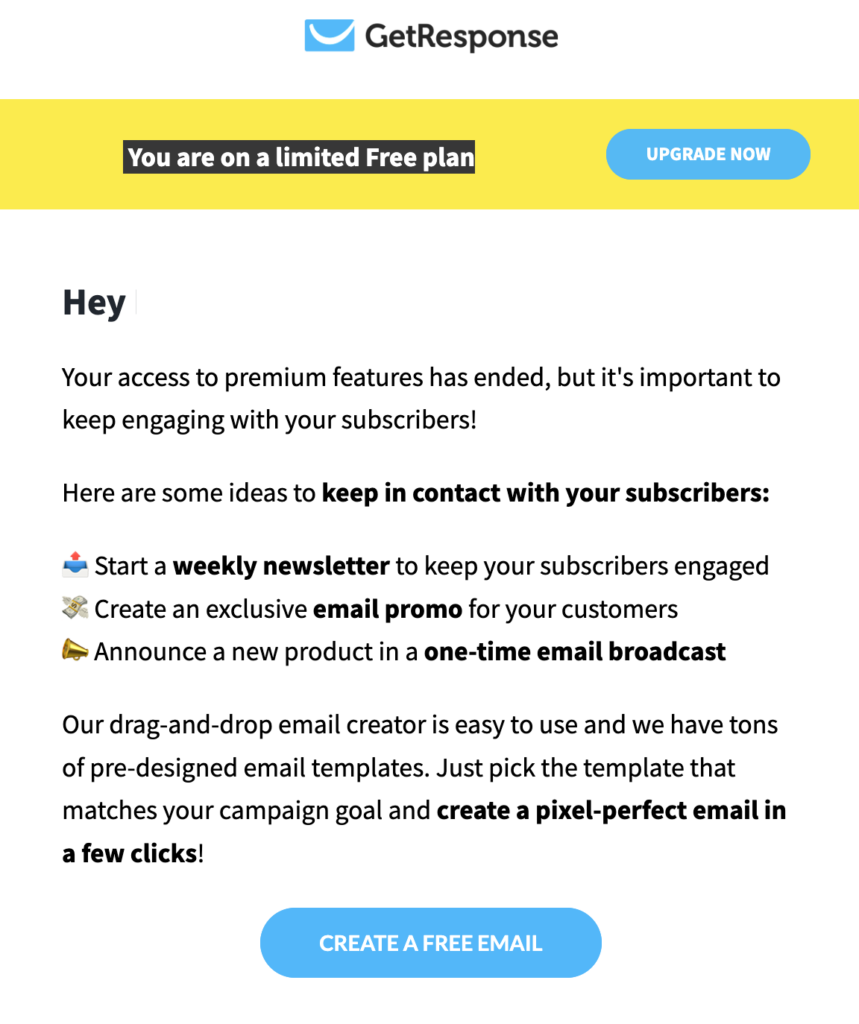
Renewal reminders. Emails giving approaching renewal dates, summarizing value delivered, and facilitating re-subscription. This sustains long-term revenue.
Expansion offers. Segmented upsell/cross-sell emails showcasing new features, higher tiers, or add-ons. They generate extra customer lifetime value.
Churn prevention. Triggers based on usage and engagement data to detect at-risk customers. Proactive outreach prevents impending cancellations.
Win-back. Targeted campaigns to revive canceled accounts by re-establishing value. Win-back initiatives maximize customer lifetime value.

Source: SaaS Email Templates
Transactional emails
Transactional emails provide service-oriented updates. They build relationships and deliver crucial information when users need it.
Consider a user signing up for a free creative design SaaS tool trial. A transactional email can give them a step-by-step guide to upgrading the tool. This ensures a seamless customer experience.
Common transactional messages include:
Account notifications. Emails to keep users in the loop about their accounts. These include password resets, billing updates, or feature additions. These kinds of messages drive accountability by keeping users informed.
Billing communications. Emails like invoices, statements, or past due notices. They facilitate subscription payments and business processes. Automated billing emails ease these recurring tasks.
Support ticket updates. Emails to keep users informed of the progress of their questions or issues. Ticket updates continue the conversation and close the loop on problems, building trust.
Shipment notifications. Alerts that a physical order has shipped out and is en route to the customer. Shipment emails provide tracking information and set delivery expectations.
Usage milestone alerts. Emails informing users when they cross thresholds for key product usage metrics. These could include storage used, projects completed, or queries run. Milestones build loyalty.
Purchase confirmations. Receipts or order confirmations that document completed purchases, upgrades, or add-ons. These confirm transaction details for user records.
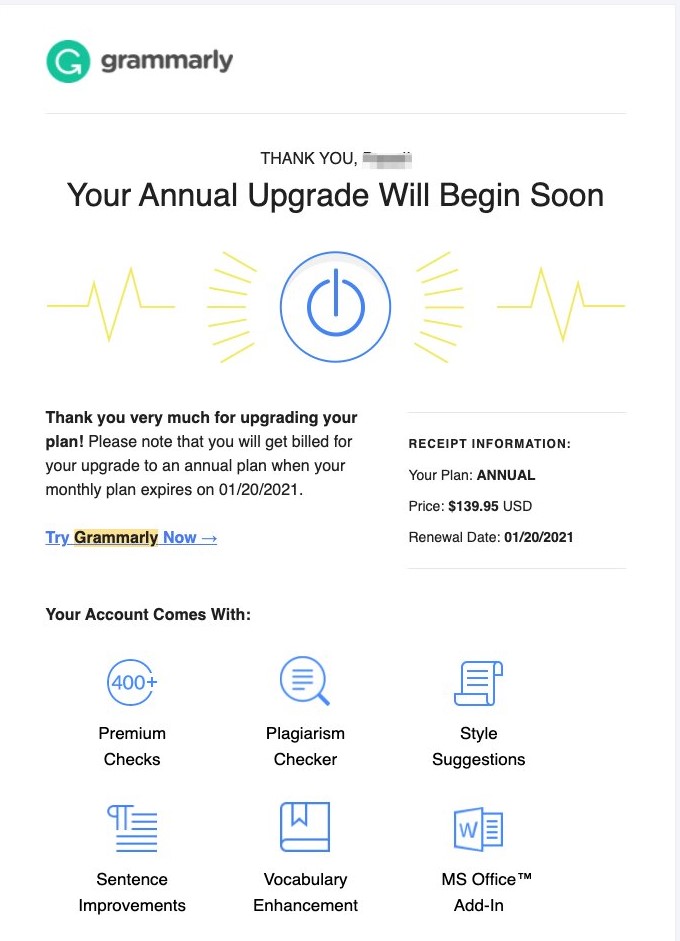 Source: Userlist
Source: Userlist
With targeted messaging for each stage, SaaS email marketing nurtures relationships over time. As the SaaS email marketing examples above show, companies can:
- Elevate their customer engagement
- Increase retention rates
- Boost their success
However, they must understand and utilize these email categories to do so.
Main pillars of a SaaS email marketing strategy
A solid SaaS email marketing strategy rests on foundational pillars critical to success. These core pillars comprise:
- Growing your contact list
- Segmentation and targeted communication
- Email content
These essential pillars optimize engagement, retention, conversions, and growth. Additionally, they help SaaS companies drive impactful campaigns tailored to their unique needs.
Growing your contact list
Successful SaaS email marketing strategies thrive on a healthy and expanding contact list.
Growing this list is more than just a numbers game. It’s about cultivating a community of interested and engaged users. A well-nurtured contact list becomes a wellspring of conversions and brand loyalty.
That’s why expanding your email subscriber list should be the first priority. A larger list equals a broader reach and impact. Ways to grow contacts include:
- Embedding opt-in forms, especially on high-traffic pages. This can be on your website, blog, help center pages, and other digital properties. Exit-intent popups can capture leads who may otherwise leave.
- Using social media posts and paid ads promoting opt-in offers. Contests and giveaways also help build contacts.
- Collecting attendee contact info at webinars, events, and tradeshows. Follow up with personalized content after.
- Encouraging customer referrals. Incentivize satisfied users with discounts, free months, or rewards when they refer friends. This reinforces their sense of community and advocacy.
- Pursuing co-marketing partnerships with complementary brands. Share relevant contacts from each other’s audience. Also, cross-promote content and offers to each other’s email lists.
- Importing opted-in lists from legacy systems or external sources to jumpstart your roster. Use direct mail campaigns with QR codes linked to landing pages to capture email signups.
- Running search, social, and display ad campaigns with lead generation. For instance, target ideal user demographics with lead ads on Facebook and LinkedIn.
- Using lead magnets. Offer valuable resources like e-books, exclusive content, or discounts in exchange for emails.
 Source: Duo Strategy
Source: Duo Strategy
Continually A/B test signup offers. While at it, remove low-quality leads to focus on engaged subscribers.
Segmentation and targeted communication
Users’ needs and journeys can differ widely in the SaaS email marketing platform.
Fortunately, segmentation empowers you to communicate with precision. It divides your contact list into smaller, more focused groups. Each group’s message resonates with its recipients because it is based on shared characteristics.
You can divide your list into granular segments based on attributes like:
- User profile – Job title, industry, role, tech stack, company size
- Engagement – Open and click rates, page views, downloads
- User lifecycle stage – Free trial, early onboarding, mature, at-risk
- Account details – Plan type, renewal period, pricing level
- Feature usage – Adoption of key features, frequency
- Lead source – Organic, paid, referral, social media
- Activity data – Web visits, logins, pages per visit
- Usage stage – Prospects, new users, power users
- Demographic info – Location, age, team size
You can even have automatic segmentation (or behavioral triggers) triggered by user actions. These could include signing up for a trial or visiting certain pages.
For example, you might have a segment titled “Upcoming Subscription Renewals.” Your message might read, “Your subscription renewal is around the corner. Here’s a sneak peek of exciting new features coming your way.”
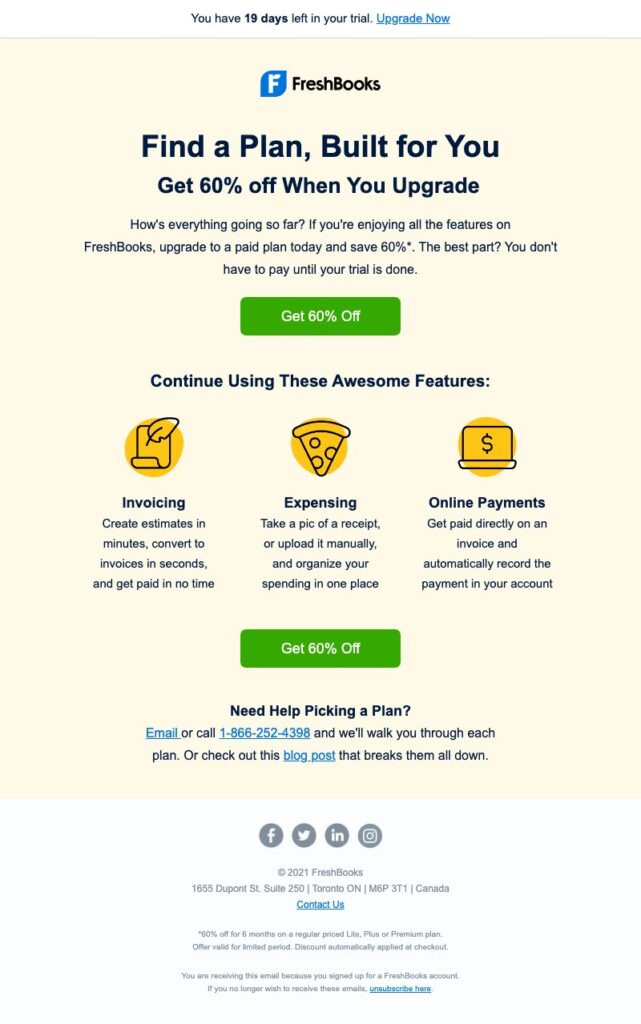 Source: SaaS Email Templates
Source: SaaS Email Templates
Automate multichannel campaigns based on user behaviors, journeys, and attributes using:
- Welcome series for driving activation from new signups
- Re-engagement flows for winning back inactive users
- Milestone or anniversary touches to reinforce loyalty
- Expansion offers for cross-sell and upsell opportunities
- Renewal reminders and sequenced retention messaging
- Behavior-triggered campaigns, like cart abandonment
- Workflows integrated with your tech stack, like CRM and help desk
Segmentation allows you to personalize communication to resonate with each user. It also allows for timely and contextually relevant communication. When doing it, match messaging to the user stage and needs.
Email content
Craft targeted, compelling and relevant content tailored to each user segment. Your content should align with user needs, offering value and driving desired actions.
Some best practices regarding email content include:
- Personalized, benefit-focused subject lines designed to get opened. Speak directly to user pain points and use dynamic fields like “user-name”.
- Education-focused content, tips, and layouts that provide valued insights. Spotlight how your product addresses user’s challenges.
- Clear calls-to-action to drive desired user actions. Base these on where users are in their journey. Remove friction from desired user actions and make it easy for them to convert.
- Mobile-optimized design with responsive templates, fast loading times, and readable fonts. Ensure excellent experience on any device.
- Dynamic content blocks from user behaviors and profile data allow personalized communication.
- Well-designed templates, content blocks, and layouts for efficiency and scalability. Create a unified brand look and experience.
- Links to targeted landing pages. These should match the offer and continue user journeys post-email.
- Consistent branding, including logo, fonts, and colors that align to your visual identity. Boost familiarity.
- A/B testing of subject lines, content sections, and designs to improve metrics like open rates. Refine based on performance data.
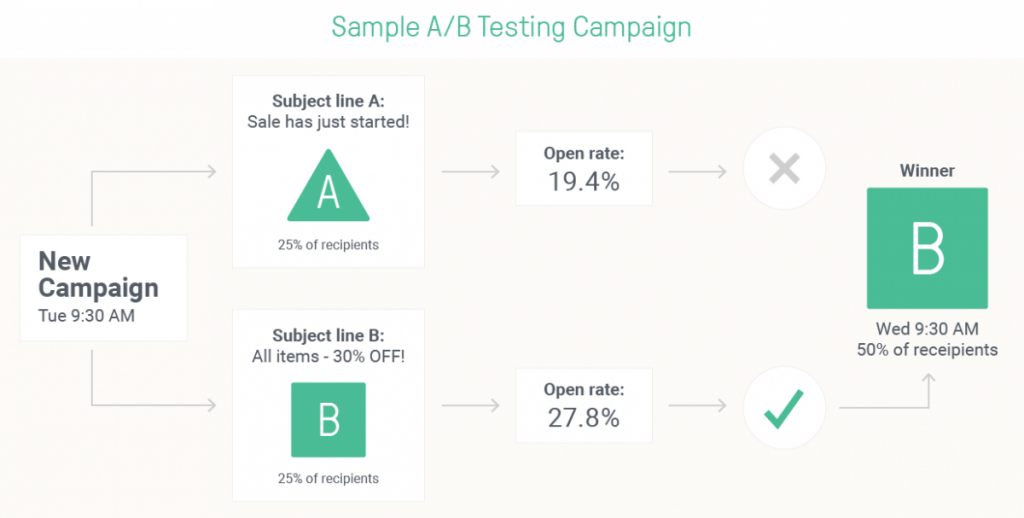 Source: Omnisend
Source: Omnisend
Crafting emails that engage and speak to users’ needs is crucial. With the right tools and strategy, targeted content fuels conversions across segments.
Four examples of SaaS businesses nailing email marketing
1.Klaviyo
In the year-wrap-up emails you can emphasize the most important things what you want to show your customers. Look at Klaviyo’s wrap-up of the year. This email is for customer retention. It shows how the platform helped customers and is a nice place to be.

Source: reallygoodemails.com
2. Intuit Mailchimp
Mailchimp launched the new feature – SMS marketing. This is an email, of how they announce about the news and provides all the information about SMS marketing benefits.

Source: reallygoodemails.com
3. Beam
This is an example from Beam how simply you can get your customers back to your platform/product.
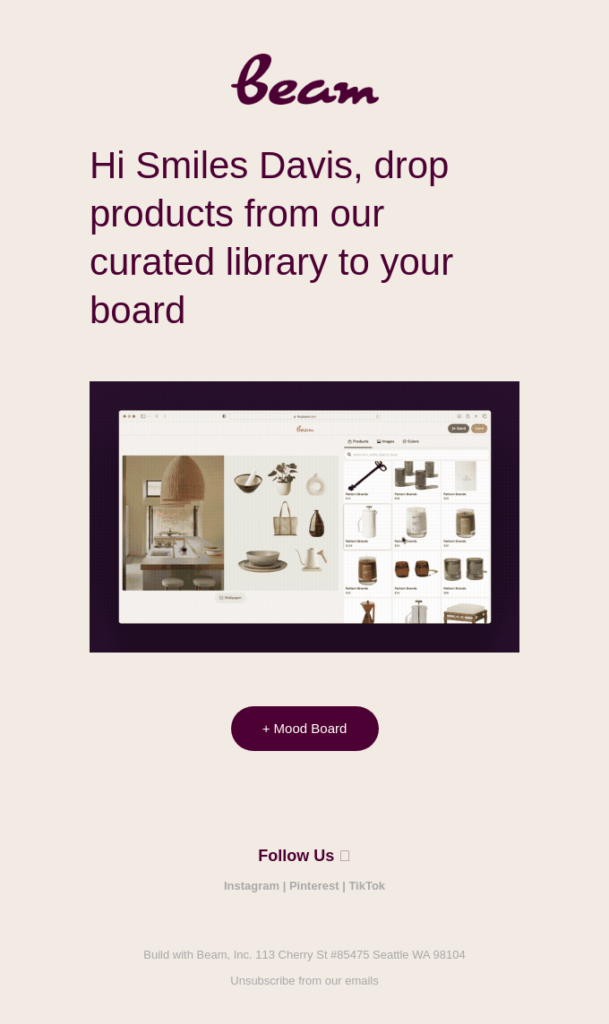
Source: reallygoodemails.com
4. Action Rocket
Take a look at the weekly newsletter introduction. What a nice idea to start an ordinary email in unordinary way and spread positivity.

Source: reallygoodemails.com
What platforms can help you implement your SaaS email marketing strategy?
Choosing the right SaaS email marketing platform can be a game-changer.
Platforms purpose-built with useful features like SaaS email marketing templates are empowering. They help SaaS companies deliver targeted, engaging, and efficient email campaigns.
An appropriate SaaS email marketing platform will execute effective lifecycle campaigns and automation. It’ll also drive growth. While there are many platforms to consider, not all are equally suited to your needs. Leading solutions include:
ActiveCampaign
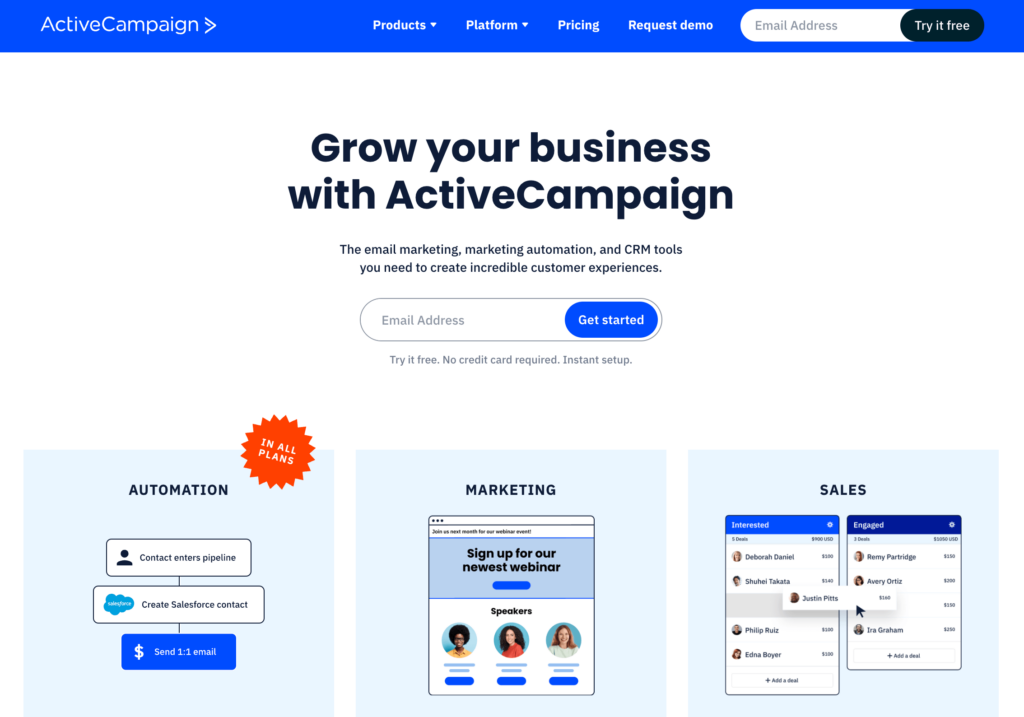
ActiveCampaign provides a robust email marketing and automation platform coupled with CRM features. This makes it well-suited for established ecommerce businesses and B2B companies.
Key strengths relevant to SaaS include:
- Deep segmentation options
- Powerful workflow automation with hundreds of pre-built “recipes”
- Native integration with marketing channels like SMS, Facebook, and Google Ads
ActiveCampaign also offers strong email deliverability and comprehensive tracking and analytics.
However, the extensive functionality can overwhelm non-technical users or marketing beginners.
While feature-rich, core elements are less aesthetically appealing out of the box. These include signup forms and email templates.
ActiveCampaign is also more expensive than competitor options. Its key limitations are a lack of free trial and key features locked on lower-tier plans.
Overall, ActiveCampaign excels at sophisticated automation and integrations ideal for mature companies. However, it may prove complex for early-stage marketers.
Check out this detailed ActiveCampaign review.
Brevo
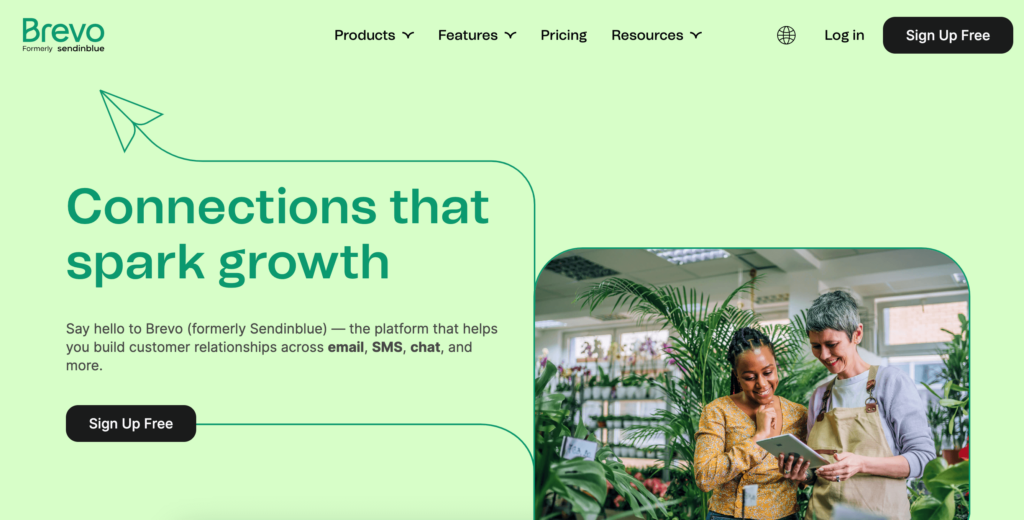
Brevo offers intuitive campaign creation capabilities and omnichannel marketing automation features. Strengths for SaaS companies include:
- Easy segmentation
- Logical automation
- Compatibility with SMS
- Push notifications
Brevo also provides useful transactional email features and affordable pay-as-you-go credits pricing.
However, limitations exist. These include basic signup forms and a lack of advanced ecommerce segmentation and reports. Brevo also requires technical setup for full functionality.
Additionally, the core email editor and templates are less robust than competitors. Brevo lacks some more advanced capabilities, like advanced personalization.
Overall, Brevo is a cost-effective option for simple email marketing and omnichannel automation. However, it is not ideal for established mid-market and enterprise SaaS companies. These need advanced segmentation, reporting, and personalization.
Brevo best suits small ecommerce businesses. It’s also suitable for early-stage/small SaaS businesses on a budget.
Read our full Brevo review.
GetResponse
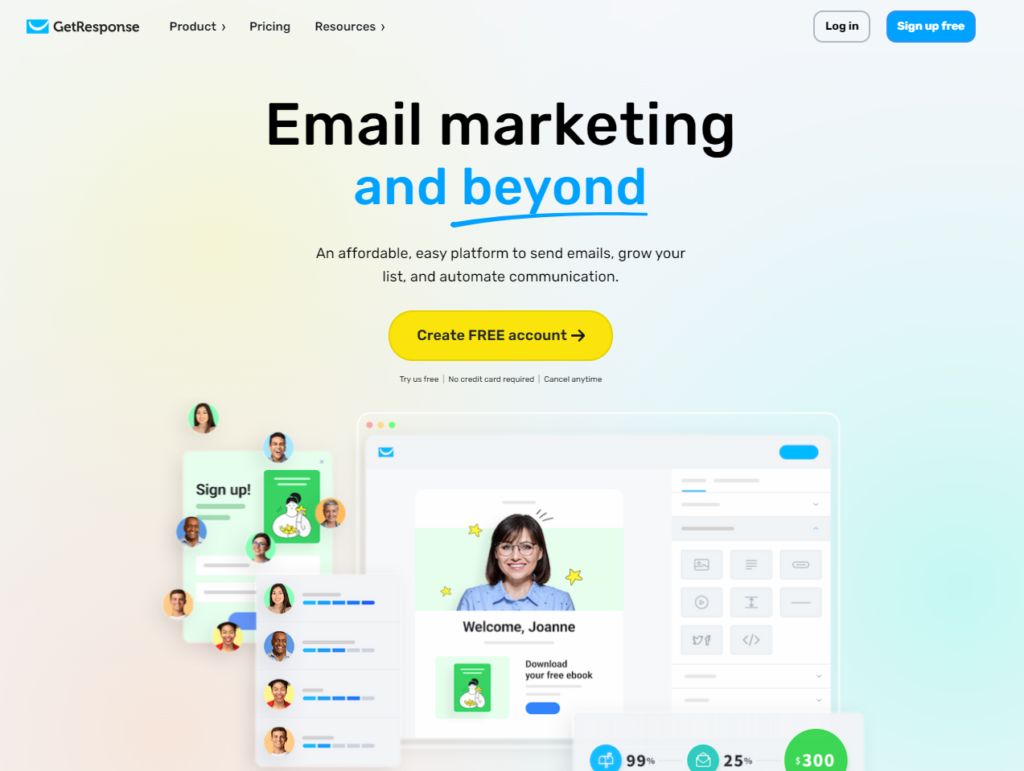
GetResponse offers an intuitive, easy-to-use platform. It has extensive email marketing and automation features relevant to SaaS.
Strengths include:
- Beautiful email templates
- Robust segmentation and reporting
- Drag-and-drop builders for emails/landing pages
- Marketing automation for workflows and lifecycle campaigns
- Sales funnels with lead scoring and nurturing capabilities
However, some limitations exist for SaaS users. Some ecommerce-specific capabilities are only available on higher tier pricing plans. These include abandoned cart automation and product recommendations.
GetResponse is a good fit for small to mid-sized SaaS businesses. With its usability and sophisticated functionality, it’s a good all-in-one marketing platform.
Find more insights in our GetResponse review.
Remember, evaluating platforms aligned to your use case is key for SaaS email success. Prioritize capabilities that support your customer experiences and growth.
Wrap up
In a crowded SaaS market, email marketing is a powerful tool. It offers a cost-effective channel to engage prospects and customers efficiently.
However, capabilities alone aren’t enough. Success hinges on understanding user needs and charting meaningful email journeys.
Relevance and relationships are crucial to turning anonymous visitors into enthusiastic advocates. To achieve this, SaaS companies must harness advanced segmentation and automation capabilities. These tools allow for precise, targeted messaging.
Ultimately, businesses must adopt and effectively execute a well-defined SaaS email marketing strategy. This way, they can fuel sustainable growth, acquire customers, and generate revenue.
